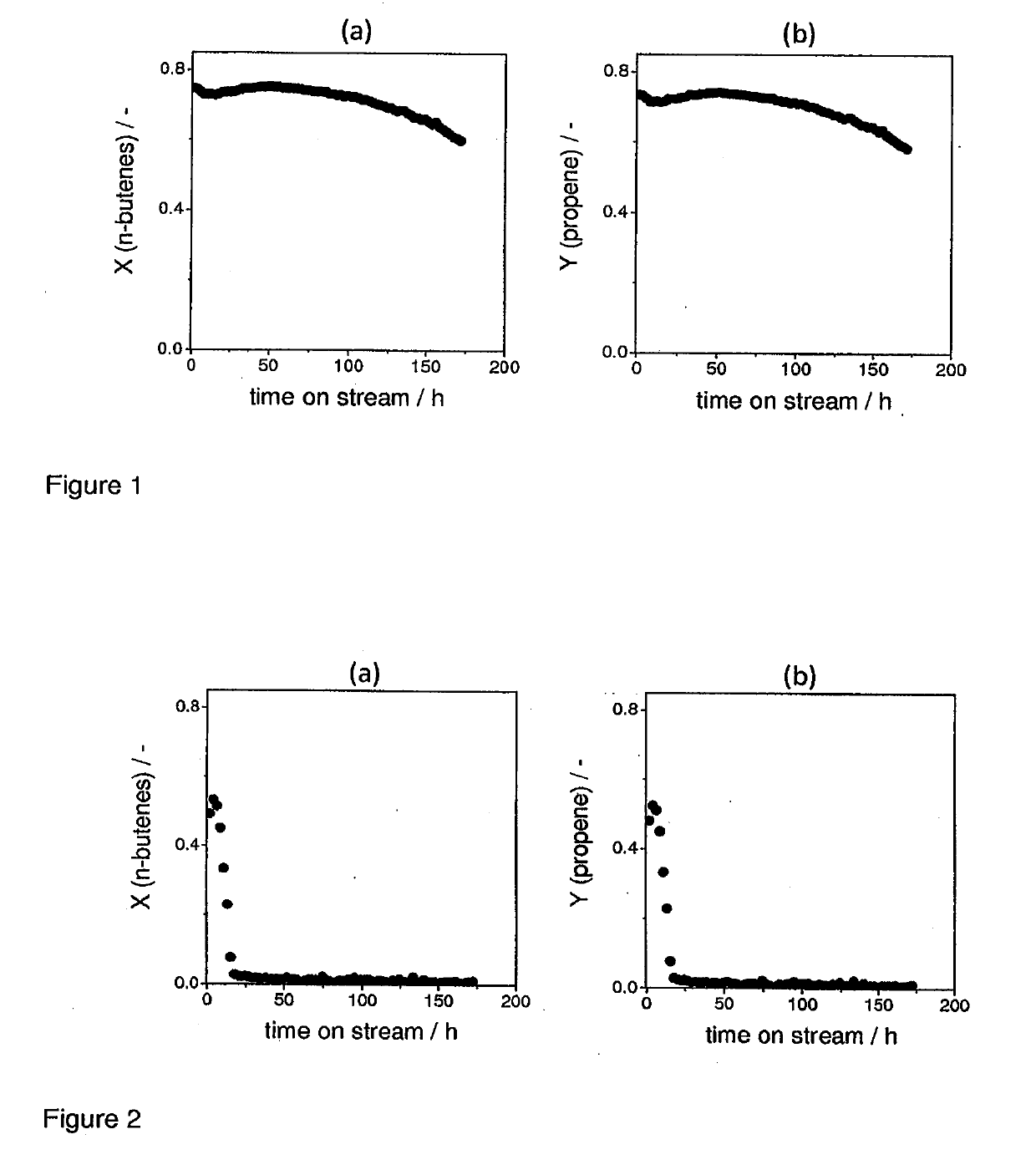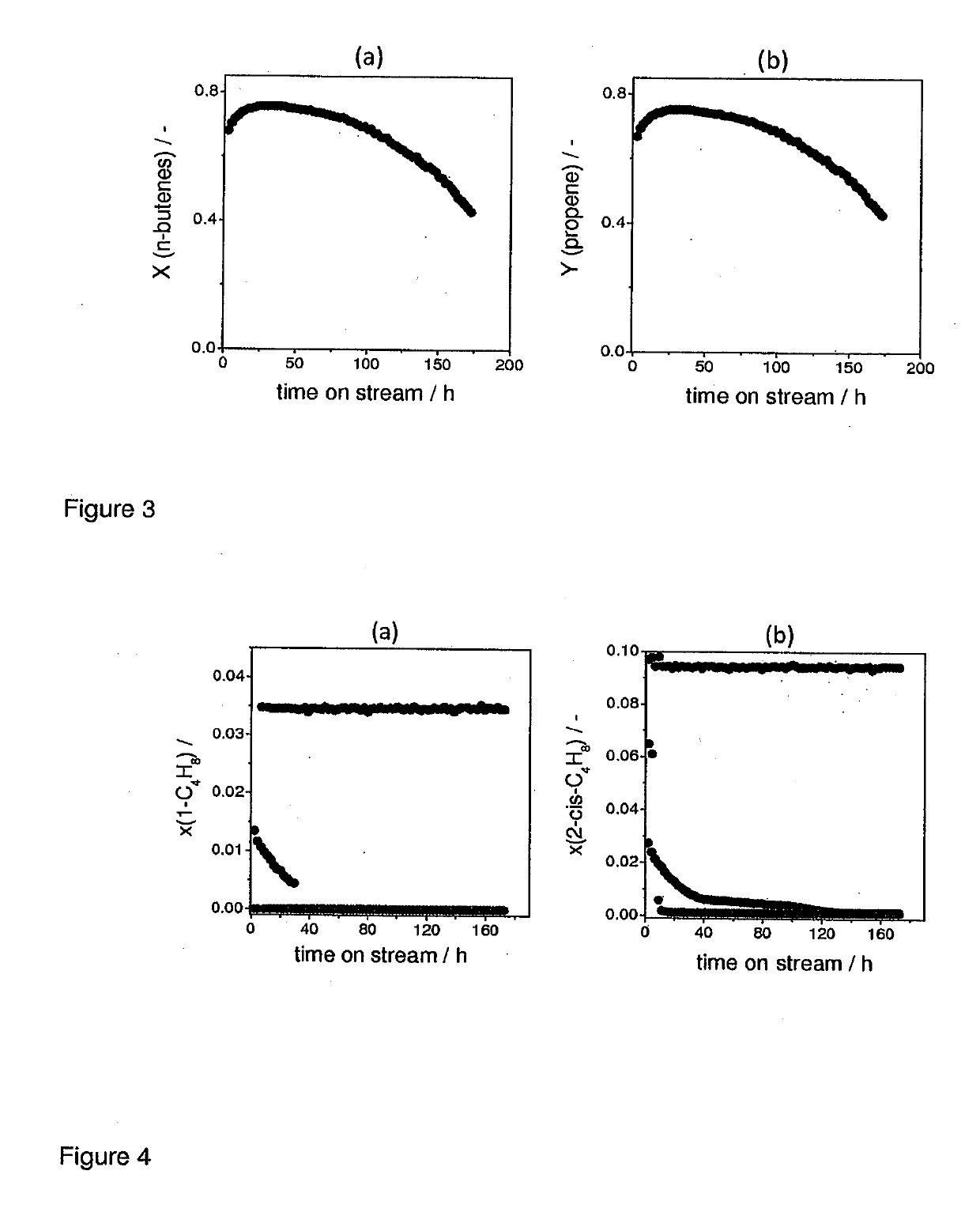Catalyst and Process for Olefin Metathesis Reaction
a technology of catalyst and reaction reaction, applied in the direction of catalyst activation/preparation, metal/metal-oxide/metal-hydroxide catalyst, etc., can solve problems such as catalyst deactivation
- Summary
- Abstract
- Description
- Claims
- Application Information
AI Technical Summary
Benefits of technology
Problems solved by technology
Method used
Image
Examples
example 1
Example
[0068]MgOL1 (MgO according to the invention) was prepared by calcination of (MgCO3)4.Mg(OH)2.5H2O at 550° C. for 16 h in an air flow. The results of MgOL1 characterisation by BET and XRD are given in Table 2 below.
[0069](WOx / SiO2)L1 was prepared by wet impregnation of SiO2 (Aerolyst® 3038, Evonik) with a solution of ammonium metatungstate hydrate (Aldrich 99.99%, trace metals basis) and potassium hydroxide (Merck). The tungsten (calculated for WO3) and potassium (calculated for K2O) loadings were set to approximately 7 and 0.2 wt. %, respectively, as described in U.S. Pat. No. 4,575,575. The dried catalyst precursors were calcinated in a muffle oven with circulating air flow at 538° C. for 8 h.
[0070]The calcined (WOx / SiO2)L1 and MgOL1 powders were then pressed, crushed and sieved to obtain particles of 315-710 μm.
[0071]The catalyst was then activated according to activation steps as outlined in Table 1.
TABLE 1activation procedure for catalystTstart / Tend / Heating rate / Holding t...
example 2
ve Example
[0074]MgOL2 was prepared by calcination of Mg(OH)2 at 550° C. for 16 h in an air flow. The results of MgOL2 characterisation by BET and XRD are provided in Table 2 below.
[0075](WOx / SiO2)L2 was prepared similarly to (WOx / SiO2)L1 (see Example 1) but using SiO2 (Davisil™, Aldrich) instead of SiO2 (Aerolyst® 3038, Evonik). Both catalytic materials were tested as described in Example 1. It should be noted that the two support materials Aerolyst® 3038 and Davisil™ have the same surface properties and texture.
[0076]The results of metathesis and isomerization tests using this catalytic preparation are shown in FIG. 2. The diagrams of FIG. 2 show that the overall stability of MgOL2 is dramatically reduced in comparison to experiment with MgOL1.
example 3
ve Example
[0077]Commercial MgO and WOx / SiO2, were used. They are denoted as MgOc and (WOx / SiO2)C, respectively. The results of MgOC the characterization by BET and XRD are provided in Table 2 below. Both catalytic materials were tested as described in Example 2.
[0078]The results of metathesis and isomerization tests are shown in FIG. 3. The diagrams of FIG. 3 reveal that the overall stability of a commercial available MgOc is lower than of MgOL1.
[0079]FIG. 4 shows time on stream profiles of the effluent molar fractions of 1-butene and cis-2-butene formed over MgOL1 according to the invention, MgOL2 obtained from Mg(OH)2 and commercial MgOc. This direct comparison and supports the results shown in FIGS. 1-3. It is apparent that the amount of butene converted over time are dramatically improved when using the more stable MgOL1.
PUM
| Property | Measurement | Unit |
|---|---|---|
| Temperature | aaaaa | aaaaa |
| Temperature | aaaaa | aaaaa |
| Temperature | aaaaa | aaaaa |
Abstract
Description
Claims
Application Information
 Login to View More
Login to View More - R&D
- Intellectual Property
- Life Sciences
- Materials
- Tech Scout
- Unparalleled Data Quality
- Higher Quality Content
- 60% Fewer Hallucinations
Browse by: Latest US Patents, China's latest patents, Technical Efficacy Thesaurus, Application Domain, Technology Topic, Popular Technical Reports.
© 2025 PatSnap. All rights reserved.Legal|Privacy policy|Modern Slavery Act Transparency Statement|Sitemap|About US| Contact US: help@patsnap.com


